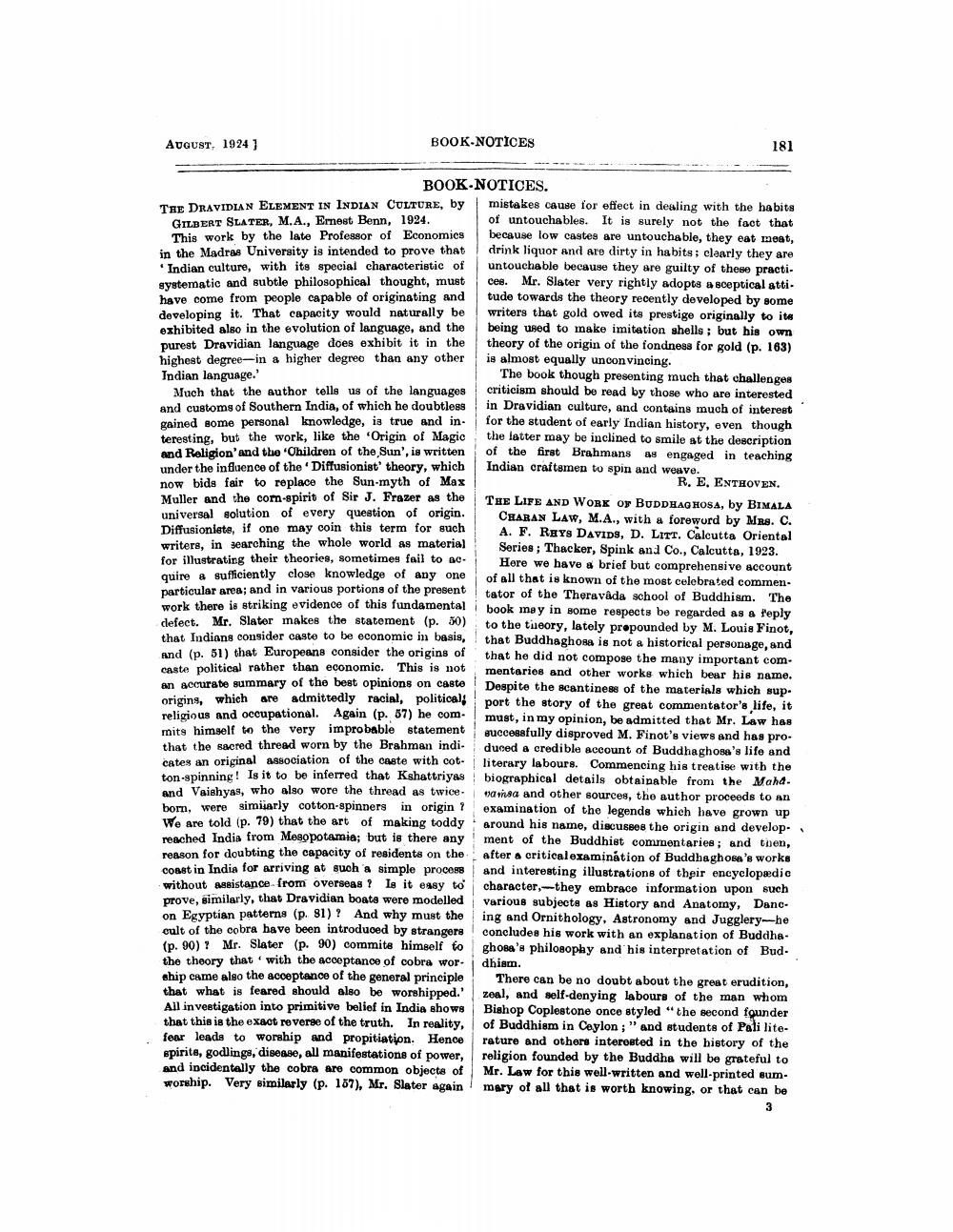________________
BOOK NOTICES
181
AUGUST, 1924 ]
BOOK-NOTICES. TA DRAVIDIAN ELEMENT IN INDIAN CULTURE, by mistakes cause for effect in dealing with the habits GILBERT SLATER, M.A., Emest Benn, 1924.
of untouchables. It is surely not the fact that This work by the late Professor of Economics because low castes are untouchable, they eat meat, in the Madras University is intended to prove that drink liquor and are dirty in habits; clearly they are
Indian culture, with its special characteristic of untouchable because they are guilty of these practisystematic and subtle philosophical thought, must cee. Mr. Slater very rightly adopts a sceptical atti. have come from people capable of originating and tude towards the theory recently developed by some developing it. That capacity would naturally be writers that gold owed its prestige originally to its exhibited also in the evolution of language, and the being used to make imitation shells but purest Dravidian language does exhibit it in the theory of the origin of the fondness for gold (p. 163) highest degree in a higher degree than any other is almost equally unconvincing. Indian language.
The book though presenting much that challenges Much that the author tells us of the languages criticism should be read by those who are interested and customs of Southern India, of which he doubtless in Dravidian culture, and contains much of interest gained some personal knowledge, is true and in for the student of early Indian history, even though teresting, but the work, like the "Origin of Magic the latter may be inclined to smile at the description And Religion and the "Ohildren of the Sun', is written of the first Brahmans engaged in teaching under the influence of the 'Diffusionist' theory, which Indian craftsmen to spin and weave. now bids fair to replace the Sun-myth of Max
R. E. ENTHOVEN, Muller and the com-spirit of Sir J. Frazer as the
THE LIFE AND WORK OF BUDDHAG HOSA, by BIMALA universal solution of every question of origin.
CHARAN LAW, M.A., with a foreword by Mrs. C. Diffusionlete, if one may coin this term for such
A. F. RHYS DAVIDS, D. LITT. Calcutta Oriental writers, in searching the whole world as material
Series ; Thacker, Spink and Co., Calcutta, 1923. for illustrating their theories, sometimes fail to me
Here we have a brief but comprehensive account quire & sufficiently close knowledge of any one
of all that is known of the most celebrated commenparticular ares; and in various portions of the present tator of the Theravada school of Buddhism. The work there is striking evidence of this fundamental book mey in some respects be regarded as a teply defect. Mr. Slator makes the statement (p. 50) to the tireory, lately propounded by M. Louis Finot, that Indians consider caste to be economic in basis, that Buddhaghona is not a historical personage, and And (p. 51) that Europeans consider the origins of that he did not compose the many important com. caste political rather than economic. This is not mentaries and other works which bear his name. an accurate summary of the best opinions on caste Despite the scantiness of the materials which sup. origins, which are admittedly racial, political;
port the story of the great commentator's life, it religious and occupational. Again (p. 57) he com
must, in my opinion, be admitted that Mr. Law has ite himself to the very improbable statement successfully disproved M. Finot's views and has prothat the sacred thread worn by the Brahman indi. duced a credible account of Buddhaghoss's life and rates an original association of the caste with cot. literary labours. Commencing his treatise with the ton-spinning! Is it to be inferred that Kshattriyas biographical details obtainable from the Maha. and Vaishyas, who also wore the thread as twice. oamisa and other sources, the author proceeds to an bom, were simijarly cotton-spinners in origin? examination of the legends which have grown up We are told (p. 79) that the art of making toddy around his name, discusses the origin and develop reached India from Monopotamia; but is there any ment of the Buddhist commentaries; and then, reason for doubting the capacity of residents on the after a critical examination of Buddhaghosa's works coast in India for arriving at such a simple process and interesting illustrations of their encyclopædic without assistance from overseas? Is it easy to character,--they embrace information upon such prove, similarly, that Dravidian boats were modelled various subjecte as History and Anatomy, Danc. on Egyptian patterns (p. 81) ? And why must the ing and Ornithology, Astronomy and Jugglery-he cult of the cobra have been introduoed by strangers concludes his work with an explanation of Buddha(p. 90) ? Mr. Slater (p. 90) commits himself fo ghoss's philosophy and his interpretation of Bud. the theory that with the acceptance of cobra wor. dhiam. ship came also the acoeptance of the general principle There can be no doubt about the great erudition, that what is feared should also be worshipped. zeal, and self-denying labours of the man whom All investigation into primitive belief in India shows Bishop Coplestone once styled “the second founder that this is the exact reverse of the truth. In reality, of Buddhism in Ceylon;" and students of Pali litefear leads to worship and propitiation. Hence rature and others interested in the history of the spirits, godlings, disease, all manifestations of power, religion founded by the Buddha will be grateful to and incidentally the cobra are common objects of Mr. Law for this well-written and well-printed sumworship. Very similarly (p. 157), Mr. Slater again mary of all that is worth knowing, or that can be




